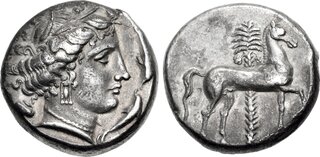| Classical Numismatic Group > Triton XXVII | Auction date: 9 January 2024 |
| Lot number: 90 Price realized: 1,900 USD (Approx. 1,740 EUR) Note: Prices do not include buyer's fees. | Show similar lots on CoinArchives Find similar lots in upcoming auctions on |
| Lot description: SICILY, Entella. Punic issues. Circa 345/38-320/15 BC. AR Tetradrachm (25mm, 16.95 g, 7h). Head of Arethousa right, wearing wreath of grain ears, triple-pendant earring, and pearl necklace; poppy behind neck, two dolphins to right / Horse stepping right; palm tree in background. Jenkins, Punic, Series 2b, 101 (O35/R92); CNP 203b; HGC 2, 275; Bement 595 (same dies); de Luynes 1437 (same dies). Lightly toned, patch of find patina along edge. Good VF. The Siculo-Punic coinage in Sicily, which included the minting of Attic weight standard tetradrachms and didrachms within Sicily by Carthage, is linked primarily to five cities: Motya, Panormos, Lilybaion, Entella, Solous, and Thermai Himerenses. Entella has been identified as the site of the main Punic controlled mint on the island, but that is disputed and it is often referred to as "uncertain." Thermai Himerenses and Solous were minor mints that issued only a few tetradrachms along with silver fractional and bronze issues. Motya, once the leading Punic city and mint in the area, ceased production after its destruction in 397 BC. This left Entella, Panormos, and Lilybaion as the major remaining mints, with Entella issuing the majority of the subsequent Punic coinage. This coinage is directly tied to Carthage's attempts to subjugate the eastern Greek half of the island. The first Sicilian War saw Carthage crushed at the Battle of Himera in 480 BC, and for seventy years after Carthage declined to interfere in Greek Sicilian politics even when called upon. However, this stance changed with her intervention on behalf of Segesta against Selinos and Himera in the Second Sicilian War. Notably, before Punic intervention, Carthage did not mint any coins at all. Instead, Punic trade across the Mediterranean was conducted in kind rather than with currency. However, Carthage needed to hire mercenaries to bolster her armies in her quest to conquer Sicily and this required currency that the mercenaries would trust. While the earliest Siculo-Punic tetradrachms had a distinctly Punic style that did not match with current issues circulating on the island. Subsequent Carthaginian emissions, however, copied local imagery and style, producing tetradrachms and didrachms that denizens of the island were familiar with. This allowed them to easily integrate into circulation alongside the Greek issues in Sicily. This syncretism, which Carthage practiced in other areas, produced a body of coinage that is fascinating not only due to its beauty, but also because of the amalgamation of styles and cultures. This model would be adopted for almost all of the Punic coinage minted in Sicily. The coins were identified as inherently Punic by alterations in style or use of a Punic legend or symbol such as the horse. However, the core concepts of the coins were borrowed from Syracuse, Akragas, Himera, and other Greek cities in Sicily. Even in Carthage's last issue of Herakles head tetradrachms, we see the use of prototypes from Alexander's different mints in the East. This amalgamation of cultures is what makes the series interesting to collect outside of its beauty and history: the ability to buy one coin that has elements from three or even four cultures is difficult to beat and is attractive to collectors of almost any area. In this auction we are proud to offer an impressive section of Siculo-Punic coins that includes coins from most of the major mints as well as a few impressive rarities that rarely appear at auction. Estimate: 2000 USD |  |



